Forty Years of Wetland Status and Trends Analyses in the Great Lakes Using Landsat Archive Imagery and Google Earth Engine
Abstract
:1. Introduction
2. Materials and Methods
2.1. Study Area
2.2. Field Data
2.3. Satellite Data
2.4. Methodology
2.4.1. Field Data Preparation
2.4.2. Unchanged Field Samples Selection
2.4.3. Classification
- Accuracy assessment
2.4.4. Change Detection (CD)
- Change Detection (CD) between two time intervals
- Change Detection (CD) through all time intervals
3. Results and Discussion
3.1. Classification
3.1.1. Classified Maps
3.1.2. Accuracy Levels
3.2. Change Analysis
3.2.1. Overall Change
3.2.2. Change Trend Analysis
3.2.3. Gain and Loss
3.2.4. Transition between Classes
4. Limitations and Suggestions
5. Conclusions
Author Contributions
Funding
Acknowledgments
Conflicts of Interest
References
- Mahdavi, S.; Salehi, B.; Granger, J.; Amani, M.; Brisco, B.; Huang, W. Remote sensing for wetland classification: A comprehensive review. GISci. Remote Sens. 2018, 55, 623–658. [Google Scholar] [CrossRef]
- Fisher, J.; Acreman, M.C. Wetland nutrient removal: A review of the evidence. Hydrol. Earth Syst. Sci. 2004, 8, 673–685. [Google Scholar] [CrossRef] [Green Version]
- Hey, D.L.; Kostel, J.A.; Crumpton, W.G.; Mitsch, W.J.; Scott, B. The roles and benefits of wetlands in managing reactive nitrogen. J. Soil Water Conserv. 2012, 67, 47A–53A. [Google Scholar] [CrossRef] [Green Version]
- Kingsford, R.T.; Basset, A.; Jackson, L. Wetlands: Conservation’s poor cousins. Aquat. Conserv. Mar. Freshw. Ecosyst. 2016, 26, 892–916. [Google Scholar] [CrossRef] [Green Version]
- Amani, M.; Mahdavi, S.; Kakooei, M.; Ghorbanian, A.; Brisco, B.; DeLancey, E.; Toure, S.; Reyes, E.L. Wetland Change Analysis in Alberta, Canada Using Four Decades of Landsat Imagery. IEEE J. Sel. Top. Appl. Earth Obs. Remote Sens. 2021, 14, 10314–10335. [Google Scholar] [CrossRef]
- Mahdianpari, M.; Jafarzadeh, H.; Granger, J.E.; Mohammadimanesh, F.; Brisco, B.; Salehi, B.; Homayouni, S.; Weng, Q. A large-scale change monitoring of wetlands using time series Landsat imagery on Google Earth Engine: A case study in Newfoundland. GISci. Remote Sens. 2020, 57, 1102–1124. [Google Scholar] [CrossRef]
- Mahdavi, S.; Salehi, B.; Amani, M.; Granger, J.E.; Brisco, B.; Huang, W.; Hanson, A. Object-based classification of wetlands in Newfoundland and Labrador using multi-temporal PolSAR data. Can. J. Remote Sens. 2017, 43, 432–450. [Google Scholar] [CrossRef]
- Varin, M.; Theau, J.; Fournier, R.A. Mapping ecosystem services provided by wetlands at multiple spatiotemporal scales: A case study in Quebec, Canada. J. Environ. Manag. 2019, 246, 334–344. [Google Scholar] [CrossRef] [PubMed]
- Mitsch, W.J.; Gosselink, J.G. The value of wetlands: Importance of scale and landscape setting. Ecol. Econ. 2000, 35, 25–33. [Google Scholar] [CrossRef]
- Lillo, A.; Matteau, J.-P.; Kokulan, V.; Benalcazar, P. The Contribution of Wetlands Towards a Sustainable Agriculture in Canada; The Canadian Agri-Food Policy Institute: Ottawa, ON, Canada, 2019. [Google Scholar]
- DeLancey, E.R.; Simms, J.F.; Mahdianpari, M.; Brisco, B.; Mahoney, C.; Kariyeva, J. Comparing Deep Learning and Shallow Learning for Large-Scale Wetland Classification in Alberta, Canada. Remote Sens. 2020, 12, 2. [Google Scholar] [CrossRef] [Green Version]
- Mahdianpari, M.; Brisco, B.; Granger, J.; Mohammadimanesh, F.; Salehi, B.; Homayouni, S.; Bourgeau-Chavez, L. The Third Generation of Pan-Canadian Wetland Map at 10 m Resolution Using Multisource Earth Observation Data on Cloud Computing Platform. IEEE J. Sel. Top. Appl. Earth Obs. Remote Sens. 2021, 14, 8789–8803. [Google Scholar] [CrossRef]
- Amani, M.; Salehi, B.; Mahdavi, S.; Granger, J.E.; Brisco, B.; Hanson, A. Wetland Classification Using Multi-Source and Multi-Temporal Optical Remote Sensing Data in Newfoundland and Labrador, Canada. Can. J. Remote Sens. 2017, 43, 360–373. [Google Scholar] [CrossRef]
- Mohammadimanesh, F.; Salehi, B.; Mahdianpari, M.; Gill, E.; Molinier, M. A new fully convolutional neural network for semantic segmentation of polarimetric SAR imagery in complex land cover ecosystem. ISPRS J. Photogramm. Remote Sens. 2019, 151, 223–236. [Google Scholar] [CrossRef]
- White, L.; Brisco, B.; Dabboor, M.; Schmitt, A.; Pratt, A. A Collection of SAR Methodologies for Monitoring Wetlands. Remote Sens. 2015, 7, 7615–7645. [Google Scholar] [CrossRef] [Green Version]
- Brisco, B.; Kapfer, M.; Hirose, T.; Tedford, B.; Liu, J. Evaluation of C-band polarization diversity and polarimetry for wetland mapping. Can. J. Remote Sens. 2011, 37, 82–92. [Google Scholar] [CrossRef]
- Merchant, M.A.; Warren, R.K.; Edwards, R.; Kenyon, J.K. An Object-Based Assessment of Multi-Wavelength SAR, Optical Imagery and Topographical Datasets for Operational Wetland Mapping in Boreal Yukon, Canada. Can. J. Remote Sens. 2019, 45, 308–332. [Google Scholar] [CrossRef]
- Brisco, B.; Murnaghan, K.; Wdowinski, S.; Hong, S.-H. Evaluation of RADARSAT-2 Acquisition Modes for Wetland Monitoring Applications. Can. J. Remote Sens. 2015, 41, 431–439. [Google Scholar] [CrossRef]
- Amani, M.; Salehi, B.; Mahdavi, S.; Brisco, B. Spectral analysis of wetlands using multi-source optical satellite imagery. ISPRS J. Photogramm. Remote Sens. 2018, 144, 119–136. [Google Scholar] [CrossRef]
- Amani, M.; Ghorbanian, A.; Ahmadi, S.A.; Kakooei, M.; Moghimi, A.; Mirmazloumi, S.M.; Moghaddam, S.H.A.; Mahdavi, S.; Ghahremanloo, M.; Parsian, S.; et al. Google Earth Engine Cloud Computing Platform for Remote Sensing Big Data Applications: A Comprehensive Review. IEEE J. Sel. Top. Appl. Earth Obs. Remote Sens. 2020, 13, 5326–5350. [Google Scholar] [CrossRef]
- Gorelick, N.; Hancher, M.; Dixon, M.; Ilyushchenko, S.; Thau, D.; Moore, R. Google Earth Engine: Planetary-scale geospatial analysis for everyone. Remote Sens. Environ. 2017, 202, 18–27. [Google Scholar] [CrossRef]
- Tamiminia, H.; Salehi, B.; Mahdianpari, M.; Quackenbush, L.; Adeli, S.; Brisco, B. Google Earth Engine for geo-big data applications: A meta-analysis and systematic review. ISPRS J. Photogramm. Remote Sens. 2020, 164, 152–170. [Google Scholar] [CrossRef]
- Valenti, V.L.; Carcelen, E.C.; Lange, K.; Russo, N.J.; Chapman, B. Leveraging Google Earth Engine User Interface for Semiautomated Wetland Classification in the Great Lakes Basin at 10 m With Optical and Radar Geospatial Datasets. IEEE J. Sel. Top. Appl. Earth Obs. Remote Sens. 2020, 13, 6008–6018. [Google Scholar] [CrossRef]
- Battaglia, M.J.; Banks, S.; Behnamian, A.; Bourgeau-Chavez, L.; Brisco, B.; Corcoran, J.; Chen, Z.; Huberty, B.; Klassen, J.; Knight, J.; et al. Multi-Source EO for Dynamic Wetland Mapping and Monitoring in the Great Lakes Basin. Remote Sens. 2021, 13, 599. [Google Scholar] [CrossRef]
- Krantzberg, G.; De Boer, C. A valuation of ecological services in the Laurentian Great Lakes Basin with an emphasis on Canada. J. Am. Water Works Assoc. 2008, 100, 100–111. [Google Scholar] [CrossRef]
- Albert, D.A.; Wilcox, D.A.; Ingram, J.W.; Thompson, T.A. Hydrogeomorphic Classification for Great Lakes Coastal Wetlands. J. Great Lakes Res. 2005, 31, 129–146. [Google Scholar] [CrossRef]
- Zhu, Z.; Woodcock, C.E. Continuous change detection and classification of land cover using all available Landsat data. Remote Sens. Environ. 2014, 144, 152–171. [Google Scholar] [CrossRef] [Green Version]
- Foga, S.; Scaramuzza, P.L.; Guo, S.; Zhu, Z.; Dilley, R.D.; Beckmann, T.; Schmidt, G.L.; Dwyer, J.L.; Joseph Hughes, M.; Laue, B. Cloud detection algorithm comparison and validation for operational Landsat data products. Remote Sens. Environ. 2017, 194, 379–390. [Google Scholar] [CrossRef] [Green Version]
- USGS. United States Geological Survey (USGS) Landsat Collection 1 Level-1 Quality Assessment Band; USGS: Reston, VA, USA. Available online: https://www.usgs.gov/landsat-missions/landsat-collection-1-level-1-quality-assessment-band (accessed on 20 April 2022).
- Ghorbanian, A.; Kakooei, M.; Amani, M.; Mahdavi, S.; Mohammadzadeh, A.; Hasanlou, M. Improved land cover map of Iran using Sentinel imagery within Google Earth Engine and a novel automatic workflow for land cover classification using migrated training samples. ISPRS J. Photogramm. Remote Sens. 2020, 167, 276–288. [Google Scholar] [CrossRef]
- Mohammadi Asiyabi, R.; Sahebi, M.R.; Ghorbanian, A. Segment-based bag of visual words model for urban land cover mapping using polarimetric SAR data. Adv. Space Res. 2021, in press. [Google Scholar] [CrossRef]
- Achanta, R.; Susstrunk, S. Superpixels and polygons using simple non-iterative clustering. In Proceedings of the IEEE Conference on Computer Vision and Pattern Recognition, Honolulu, HI, USA, 21–26 July 2017; pp. 4651–4660. [Google Scholar]
- Ghorbanian, A.; Zaghian, S.; Asiyabi, R.M.; Amani, M.; Mohammadzadeh, A.; Jamali, S. Mangrove Ecosystem Mapping Using Sentinel-1 and Sentinel-2 Satellite Images and Random Forest Algorithm in Google Earth Engine. Remote Sens. 2021, 13, 2565. [Google Scholar] [CrossRef]
- Amani, M.; Brisco, B.; Afshar, M.; Mirmazloumi, S.M.; Mahdavi, S.; Mirzadeh, S.M.J.; Huang, W.; Granger, J. A generalized supervised classification scheme to produce provincial wetland inventory maps: An application of Google Earth Engine for big geo data processing. Big Earth Data 2019, 3, 378–394. [Google Scholar] [CrossRef]
- Amani, M.; Mahdavi, S.; Afshar, M.; Brisco, B.; Huang, W.; Mohammad Javad Mirzadeh, S.; White, L.; Banks, S.; Montgomery, J.; Hopkinson, C. Canadian wetland inventory using google earth engine: The first map and preliminary results. Remote Sens. 2019, 11, 842. [Google Scholar] [CrossRef] [Green Version]
- Amani, M.; Brisco, B.; Mahdavi, S.; Ghorbanian, A.; Moghimi, A.; Delancey, E.; Merchant, M.A.; Jahncke, R.; Fedorchuk, L.; Mui, A. Evaluation of the Landsat-based Canadian Wetland Inventory Map using Multiple Sources: Challenges of Large-scale Wetland Classification using Remote Sensing. IEEE J. Sel. Top. Appl. Earth Obs. Remote Sens. 2020, 14, 32–52. [Google Scholar] [CrossRef]
- National Forestry Database. Forest Area Burned and Number of Forest Fires. Available online: http://nfdp.ccfm.org/en/data/fires.php (accessed on 28 February 2022).
- Uzarski, D.G.; Brady, V.J.; Cooper, M.J.; Wilcox, D.A.; Albert, D.A.; Axler, R.P.; Bostwick, P.; Brown, T.N.; Ciborowski, J.J.H.; Danz, N.P.; et al. Standardized Measures of Coastal Wetland Condition: Implementation at a Laurentian Great Lakes Basin-Wide Scale. Wetlands 2017, 37, 15–32. [Google Scholar] [CrossRef] [Green Version]
- National Wetlands Working Group. The Canadian Wetland Classification System; Lands Conservation Branch, Canadian Wildlife Service, Environment Canada: Toronto, ON, Candada, 1997. [Google Scholar]
- Amani, M.; Salehi, B.; Mahdavi, S.; Brisco, B. Separability analysis of wetlands in Canada using multi-source SAR data. GISci. Remote Sens. 2019, 56, 1233–1260. [Google Scholar] [CrossRef]
- Mohsenifar, A.; Mohammadzadeh, A.; Moghimi, A.; Salehi, B. A novel unsupervised forest change detection method based on the integration of a multiresolution singular value decomposition fusion and an edge-aware Markov Random Field algorithm. Int. J. Remote Sens. 2021, 42, 9376–9404. [Google Scholar] [CrossRef]
- Bourgeau-Chavez, L.L.; Riordan, K.; Miller, N.; Nowels, M.; Powell, R. Remotely Monitoring Great Lakes Coastal Wetlands with Multi-Sensor, Multi-Temporal SAR and Multi-Spectral Data. In Proceedings of the IGARSS 2008—2008 IEEE International Geoscience and Remote Sensing Symposium, Boston, MA, USA, 7–11 July 2008; pp. I-428–I-429. [Google Scholar]
- Wilcox, D.A.; Thompson, T.A.; Booth, R.K.; Nicholas, J.R. Lake-Level Variability and Water Availability in the Great Lakes; U.S. Geological Survey: Reston, VA, USA, 2007. [Google Scholar]
- Chen, Z.; White, L.; Banks, S.; Behnamian, A.; Montpetit, B.; Pasher, J.; Duffe, J.; Bernard, D. Characterizing marsh wetlands in the Great Lakes Basin with C-band InSAR observations. Remote Sens. Environ. 2020, 242, 111750. [Google Scholar] [CrossRef]
- Chen, Z.; Banks, S.; Behnamian, A.; White, L.; Montpetit, B.; Pasher, J.; Duffe, J. Characterizing the Great Lakes Coastal Wetlands with InSAR Observations from X-, C-, and L-Band Sensors. Can. J. Remote Sens. 2020, 46, 765–783. [Google Scholar] [CrossRef]

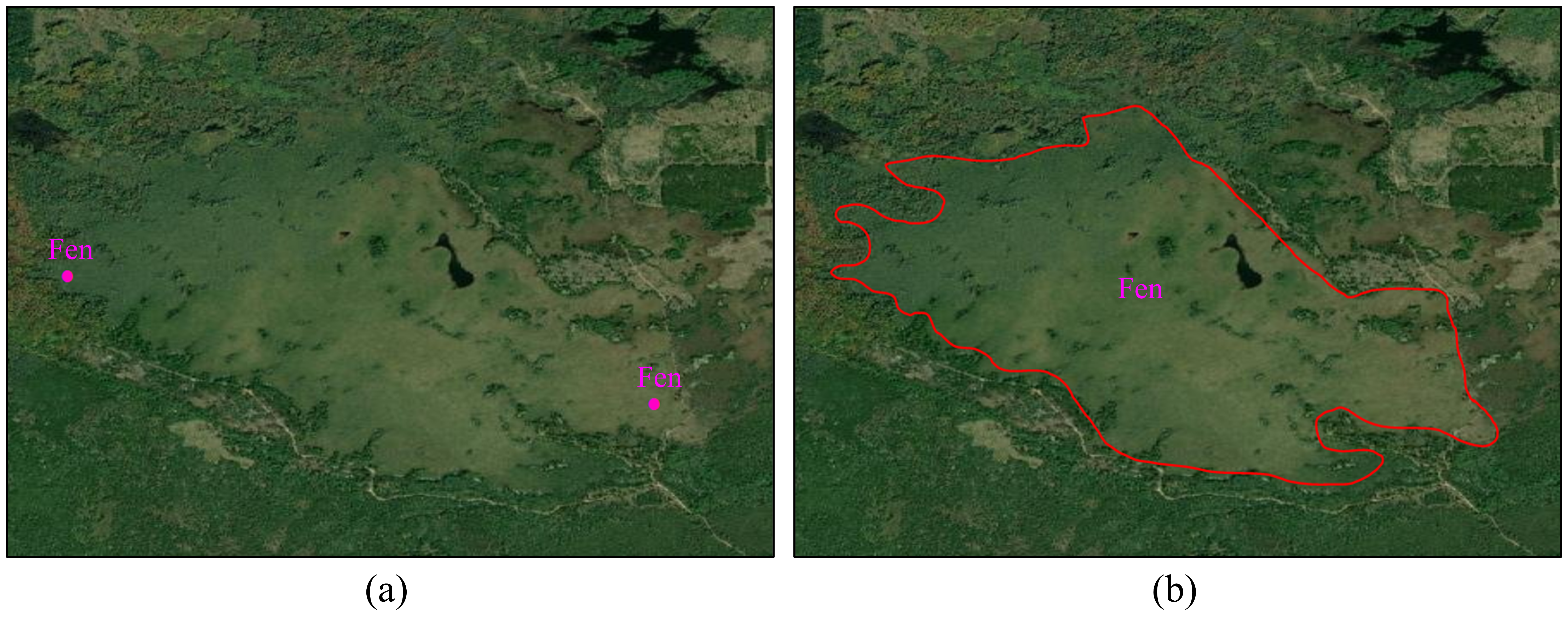

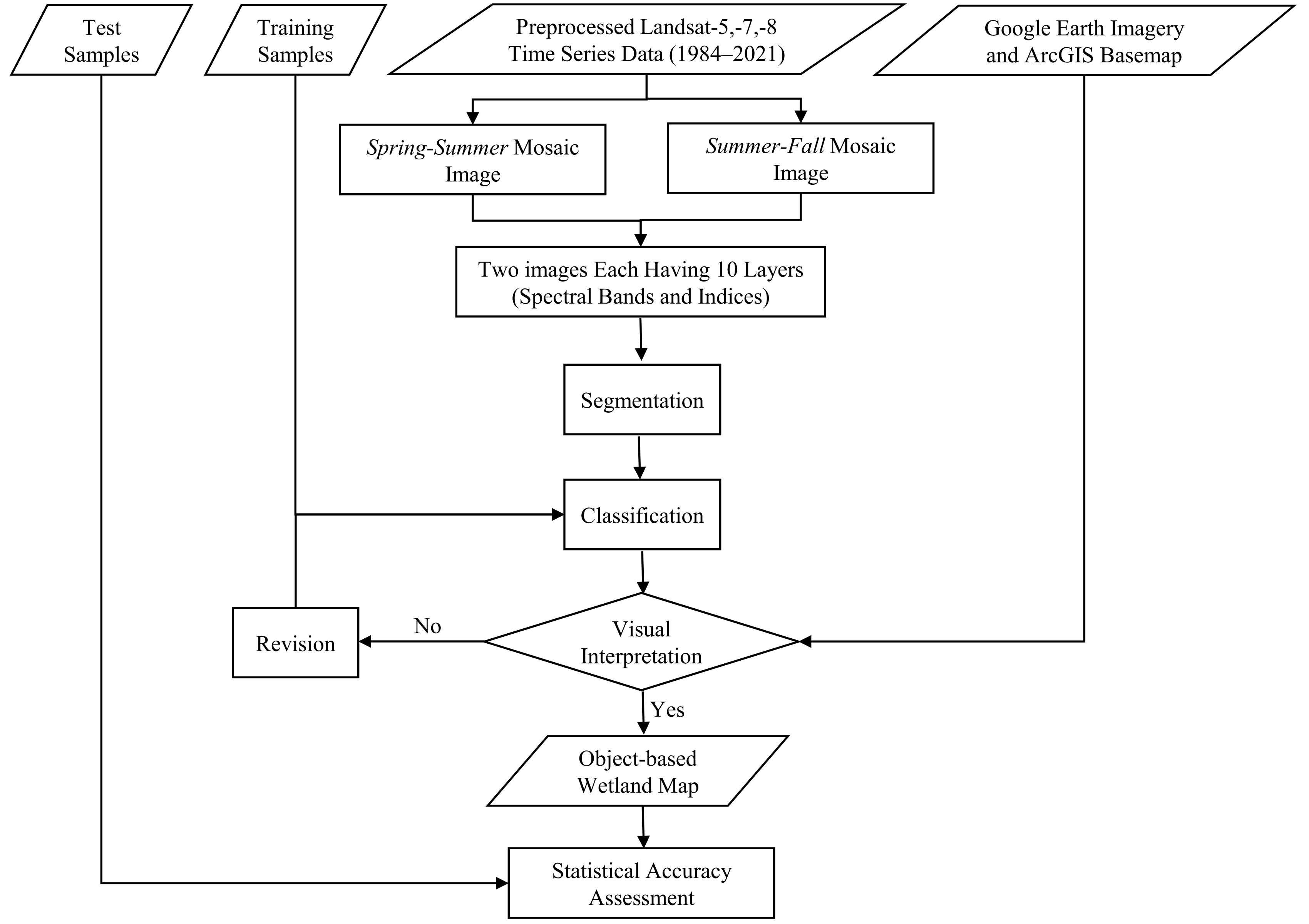
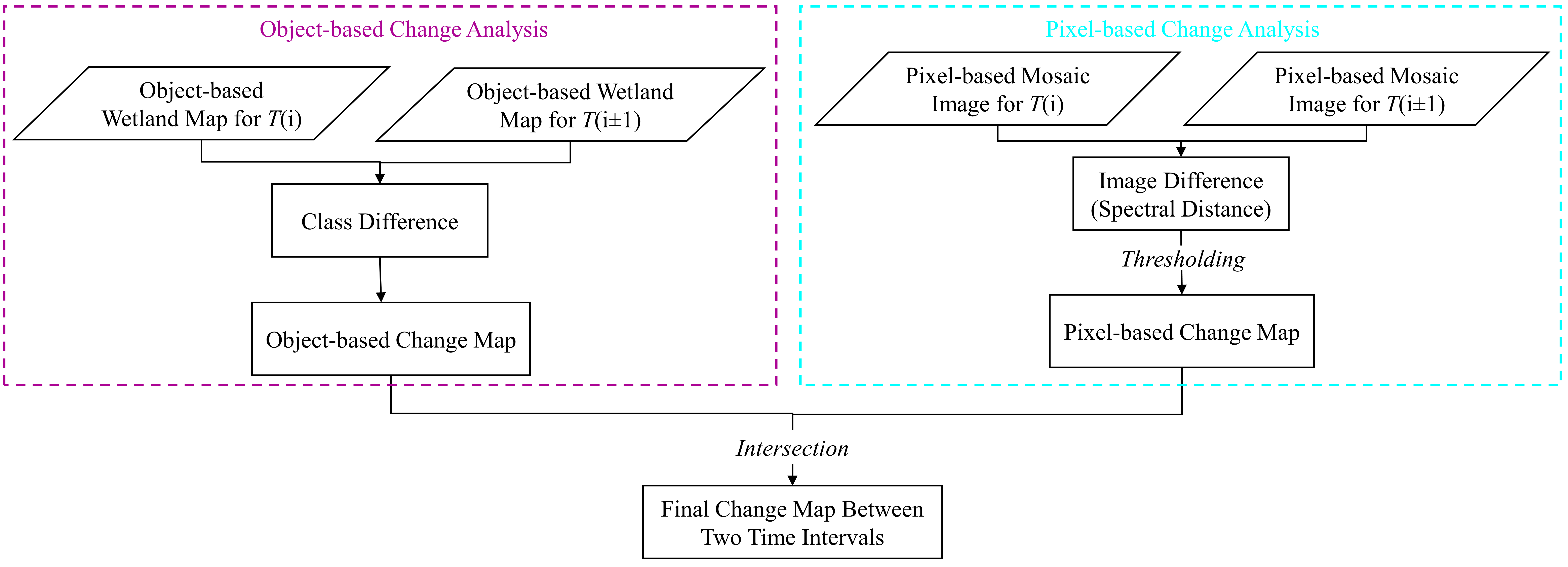

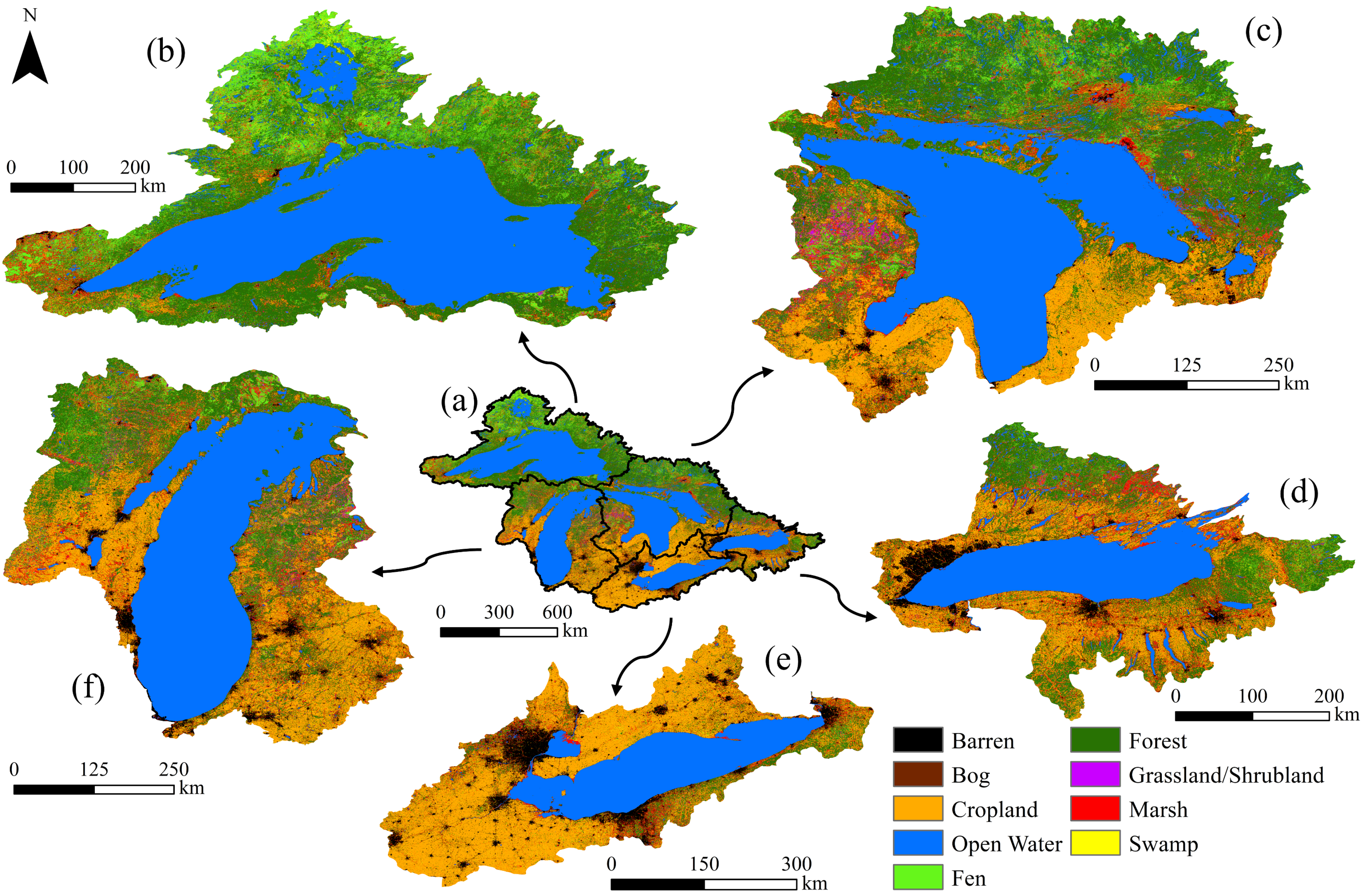
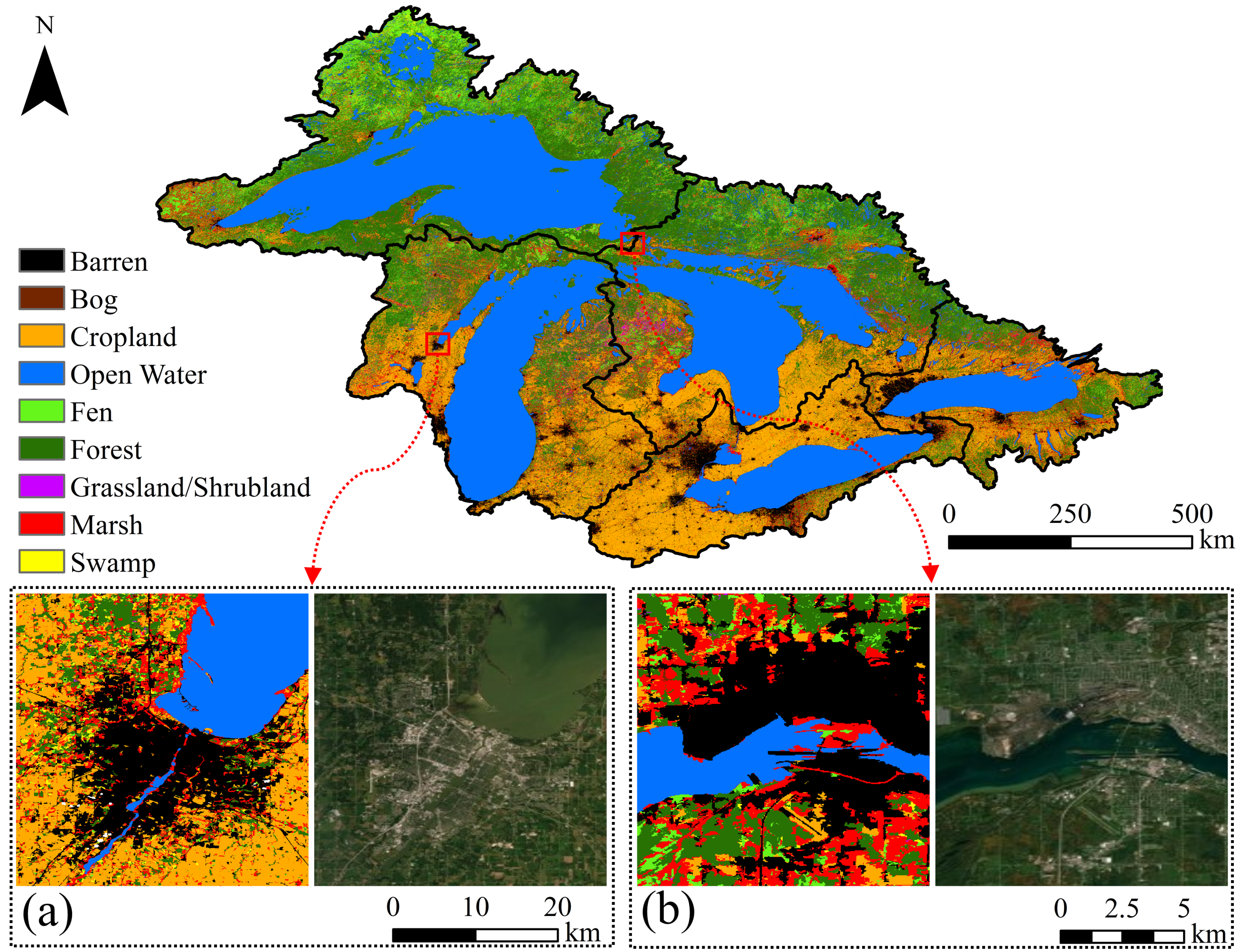

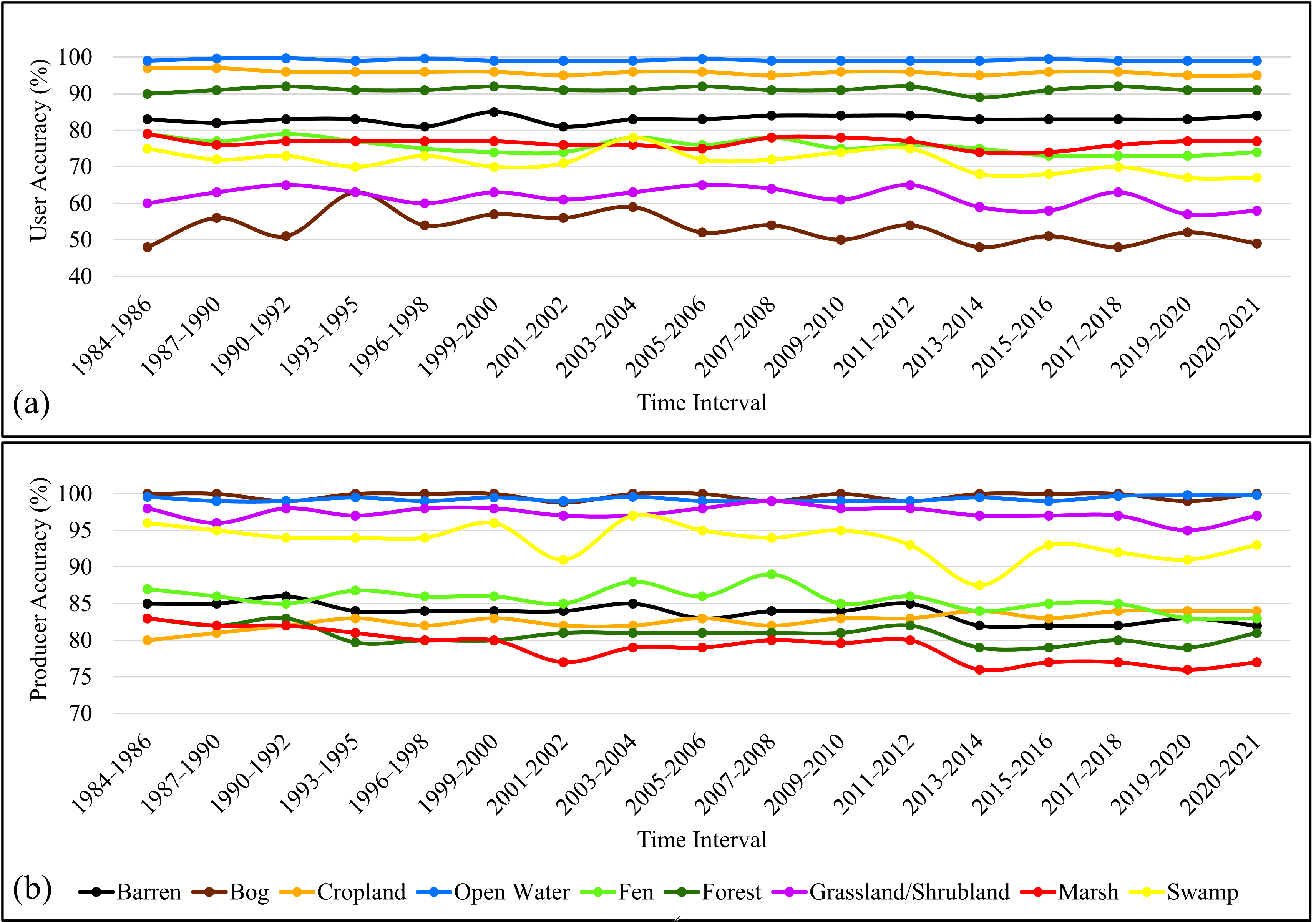
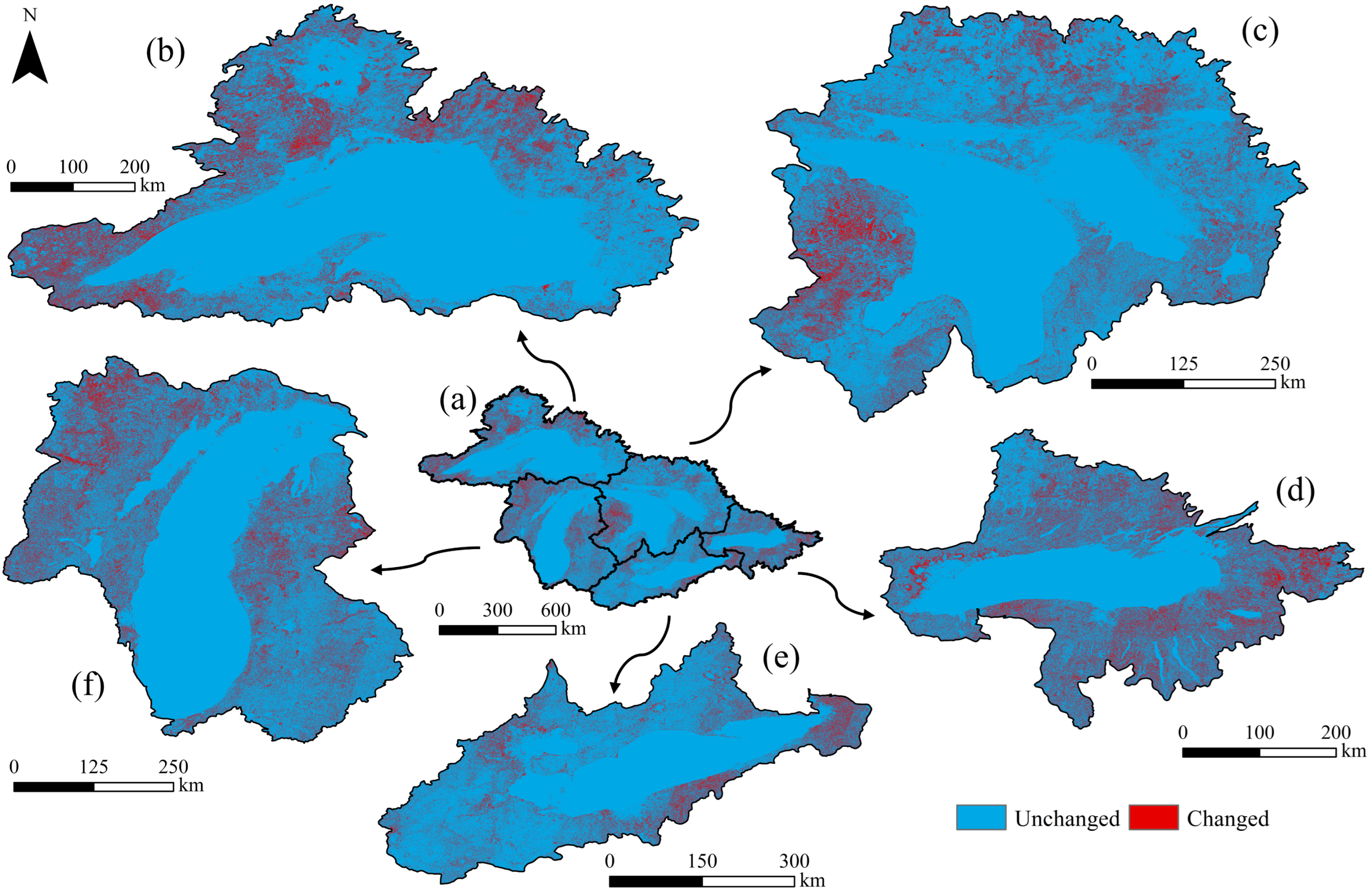
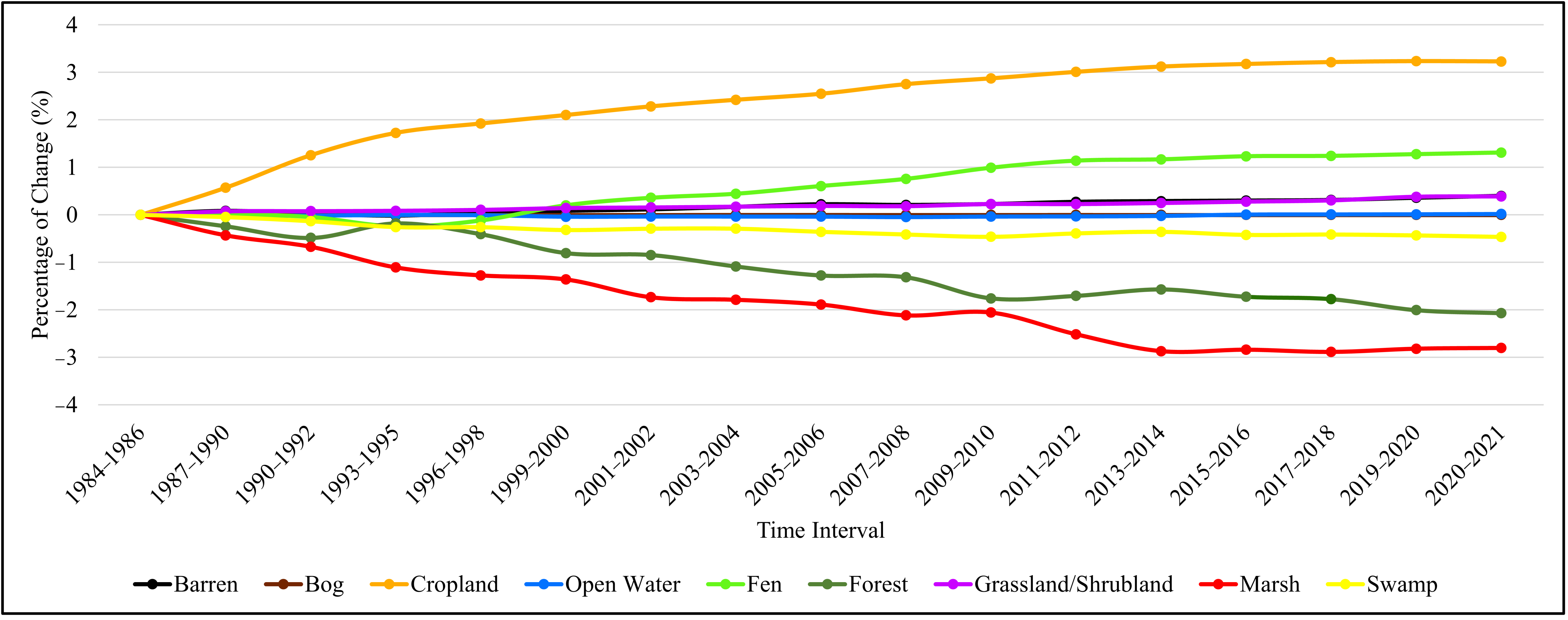
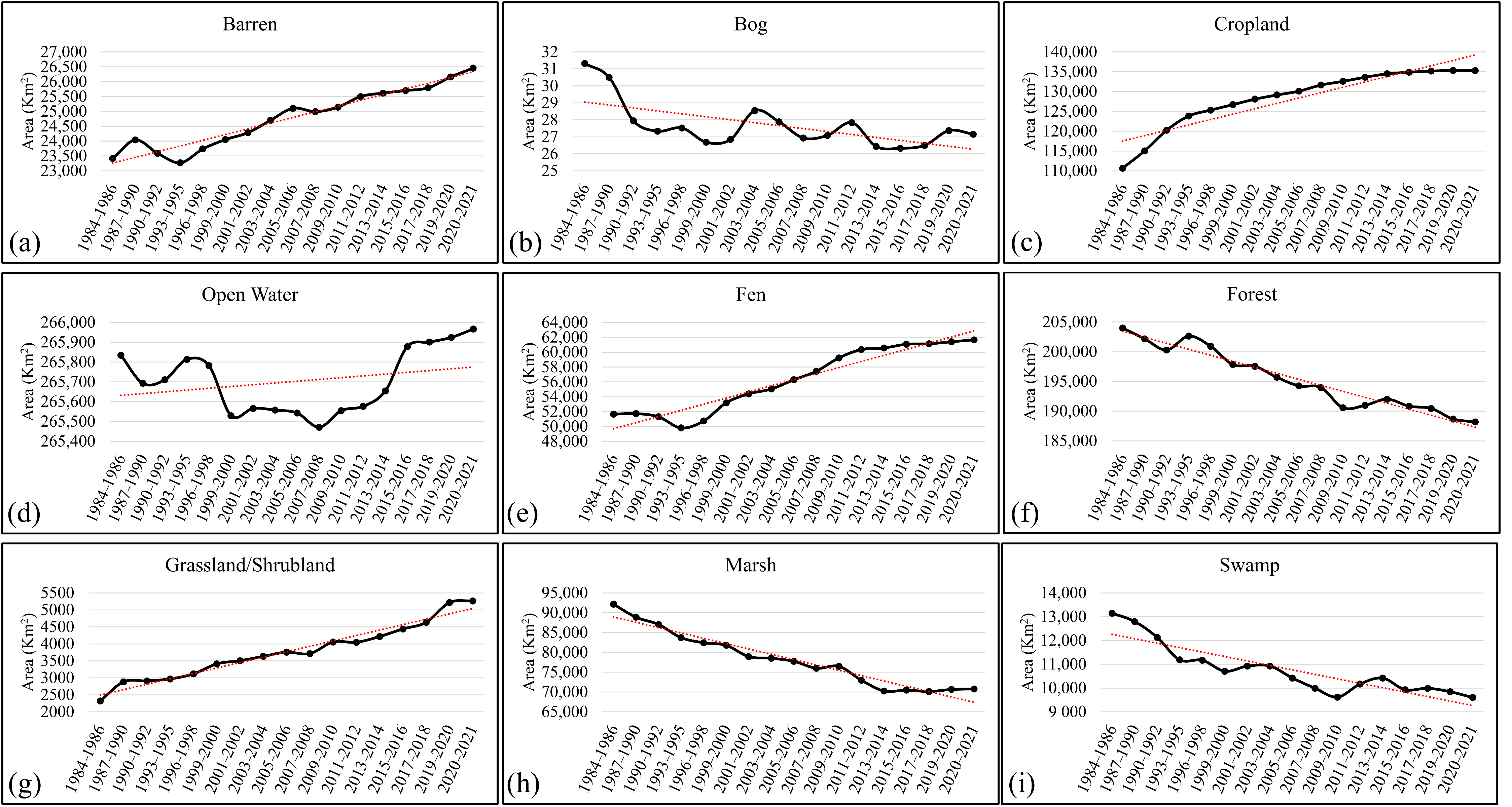

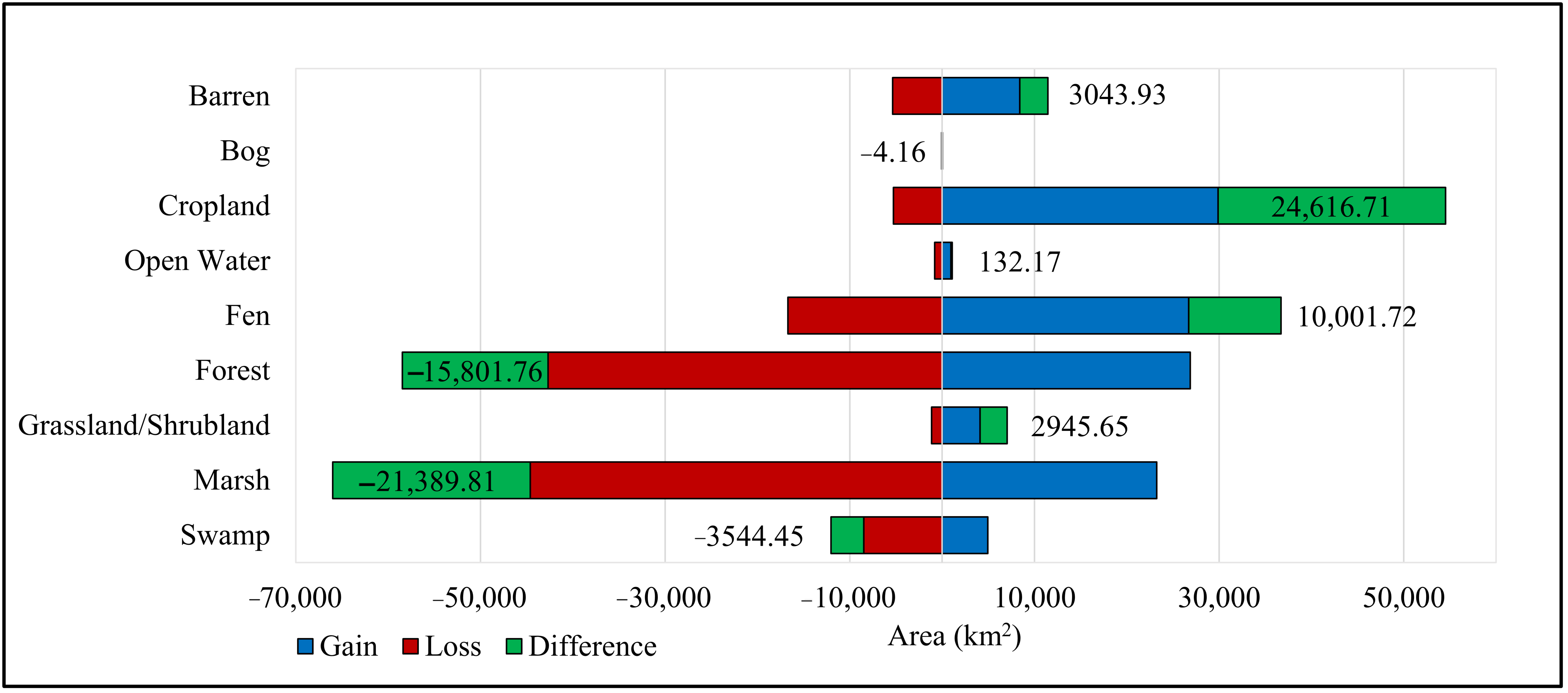
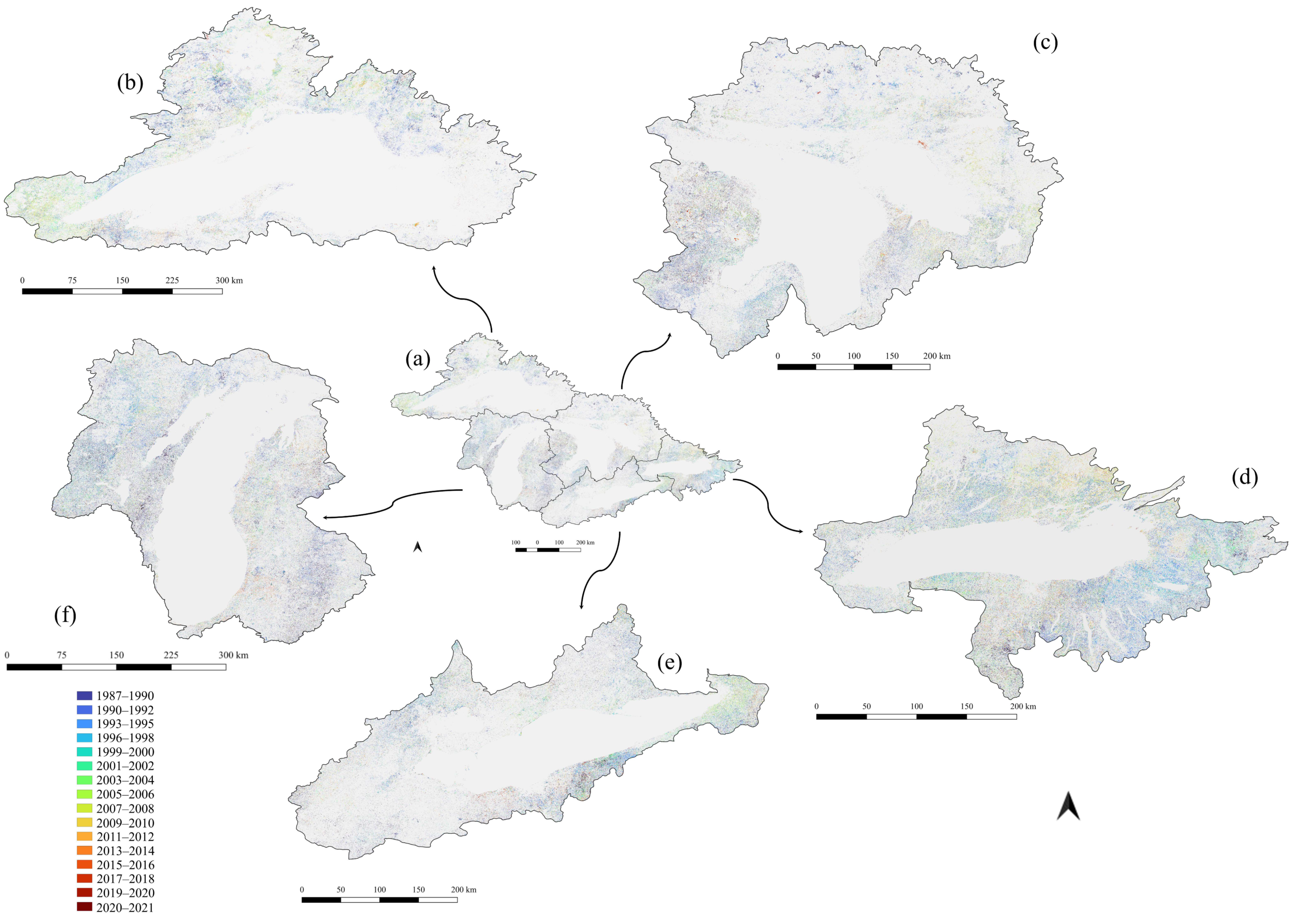
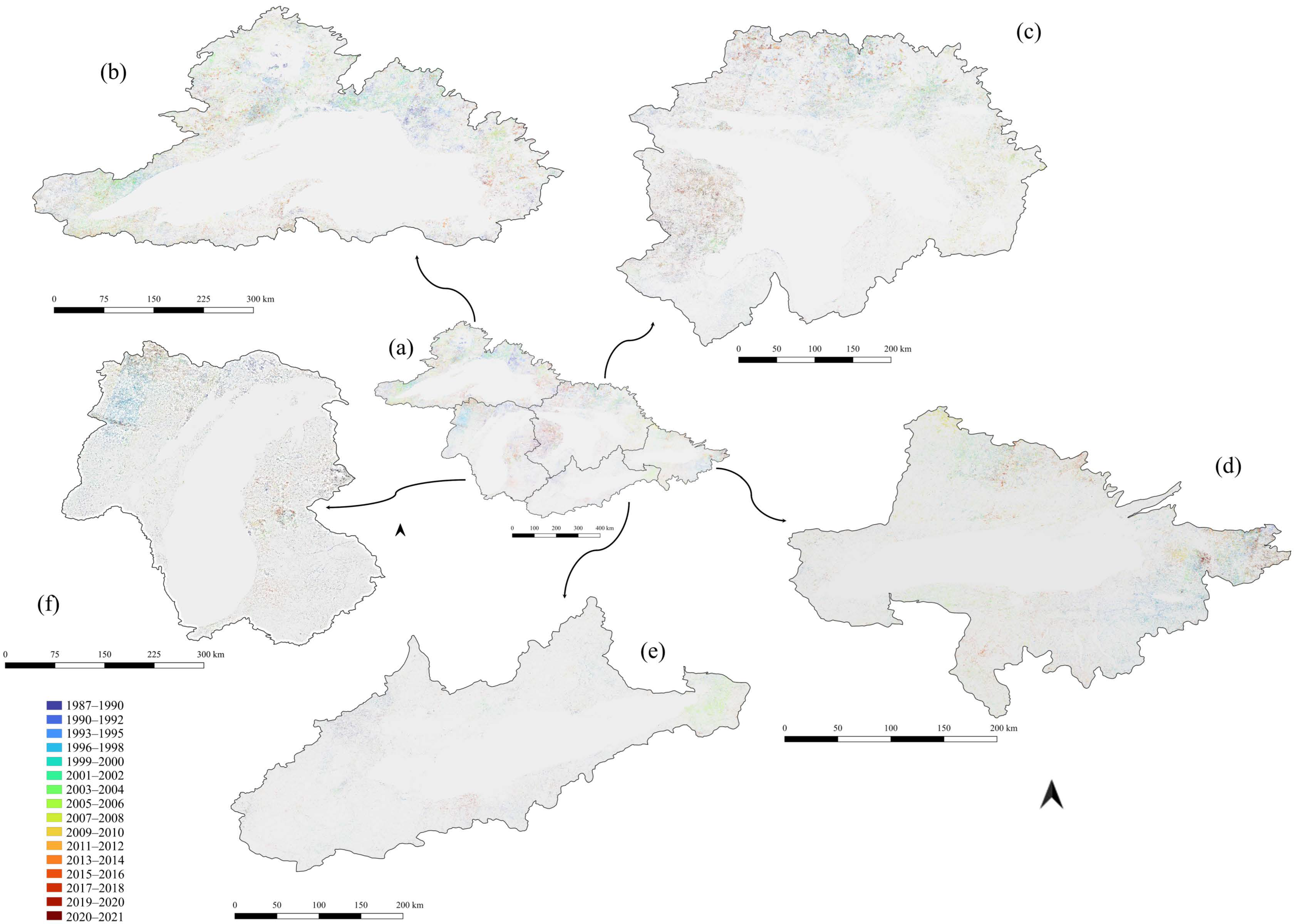
| MTRI | NASA | Dal | ECCC | OP | NDMNRF | |||||||||
|---|---|---|---|---|---|---|---|---|---|---|---|---|---|---|
| Class | # Polygons | Area (ha) | # Polygons | Area (ha) | # Polygons | Area (ha) | # Polygons | Area (ha) | # Polygons | Area (ha) | # Polygons | Area (ha) | Total # | Total Area (ha) |
| Bog | 59 | 1125.0 | 15 | 112.1 | 0 | 0 | 0 | 0 | 16 | 68.2 | 11 | 122.4 | 101 | 1427.7 |
| Fen | 99 | 5831.6 | 17 | 188.9 | 0 | 0 | 0 | 0 | 0 | 0 | 30 | 425.6 | 146 | 6446.1 |
| Marsh | 695 | 13,314.7 | 188 | 834.6 | 54 | 88.7 | 27 | 1885.4 | 0 | 0 | 116 | 1309.2 | 1078 | 17,425.6 |
| Swamp | 0 | 0 | 0 | 0 | 48 | 782.1 | 13 | 1736.3 | 0 | 0 | 211 | 3835.8 | 272 | 6354.2 |
| Open Water | 155 | 3775.2 | 0 | 0 | 113 | 51.0 | 8 | 1286.0 | 0 | 0 | 20 | 226.0 | 296 | 5338.2 |
| Forest | 43 | 1043.8 | 5 | 46.2 | 0 | 0 | 35 | 617.9 | 0 | 0 | 472 | 13,491.6 | 555 | 15,199.5 |
| Grassland/Shrubland | 0 | 0 | 0 | 0 | 0 | 0 | 0 | 0 | 300 | 1534.2 | 2 | 8.2 | 277 | 1424.0 |
| Cropland | 12 | 198.6 | 0 | 0 | 0 | 0 | 0 | 0 | 364 | 2829.5 | 4 | 37.0 | 380 | 3065.1 |
| Barren | 0 | 0 | 0 | 0 | 0 | 0 | 0 | 0 | 59 | 4368.7 | 24 | 116.7 | 81 | 4432.4 |
| Total | 1062 | 25,284.6 | 224 | 1179.2 | 215 | 921.8 | 83 | 5525.6 | 712 | 8629.0 | 890 | 19,572.5 | 3186 | 61,112.6 |
| Time Interval Number | Time Interval Range | Landsat-5 | Landsat-7 | Landsat-8 | Number of Images |
|---|---|---|---|---|---|
| T1 | 1984–1986 | - | 2530 | ||
| T2 | 1987–1989 | - | 2905 | ||
| T3 | 1990–1992 | - | 3033 | ||
| T4 | 1993–1995 | - | 2980 | ||
| T5 | 1996–1998 | - | 2997 | ||
| T6 | 1999–2000 | - | - | 4369 | |
| T7 | 2001–2002 | - | - | 4602 | |
| T8 | 2003–2004 | - | 2244 | ||
| T9 | 2005–2006 | - | 2181 | ||
| T10 | 2007–2008 | - | 1829 | ||
| T11 | 2009–2010 | - | 2117 | ||
| T12 | 2011–2012 | - | 3110 | ||
| T13 | 2013–2014 | - | - | 4862 | |
| T14 | 2015–2016 | - | - | 4868 | |
| T15 | 2017–2018 | - | - | 4811 | |
| T16 | 2019–2020 | - | - | 4710 | |
| T17 | 2020–2021 | - | - | 4361 |
| Field Samples | |||||||||||
|---|---|---|---|---|---|---|---|---|---|---|---|
| Barren | Bog | Cropland | Open Water | Fen | Forest | Grassland/Shrubland | Marsh | Swamp | Total | ||
| Barren | 1095 | 0 | 101 | 0 | 12 | 12 | 1 | 76 | 1 | 1298 | |
| Bog | 5 | 74 | 9 | 0 | 22 | 11 | 1 | 28 | 1 | 151 | |
| Cropland | 29 | 0 | 2116 | 0 | 4 | 9 | 2 | 67 | 1 | 2228 | |
| Classified | Open Water | 1 | 0 | 0 | 1225 | 2 | 0 | 0 | 6 | 0 | 1234 |
| Fen | 42 | 0 | 77 | 0 | 910 | 80 | 1 | 108 | 5 | 1223 | |
| Forest | 8 | 0 | 7 | 1 | 43 | 1191 | 0 | 48 | 4 | 1302 | |
| Grassland/Shrubland | 22 | 0 | 38 | 0 | 18 | 33 | 245 | 63 | 4 | 423 | |
| Marsh | 123 | 0 | 163 | 2 | 63 | 66 | 3 | 1383 | 4 | 1807 | |
| Swamp | 6 | 0 | 3 | 0 | 23 | 77 | 0 | 20 | 263 | 392 | |
| Total | 1095 | 0 | 101 | 0 | 12 | 12 | 1 | 76 | 1 | 1298 | |
| UA (%) | 84 | 49 | 95 | 99 | 74 | 91 | 58 | 77 | 67 | - | |
| PA (%) | 82 | 100 | 84 | 99.8 | 83 | 81 | 97 | 77 | 93 | - | |
| Overall Accuracy (OA) = 85% | Kappa Coefficient (KC) = 0.82 | ||||||||||
| 2020–2021 | ||||||||||||
|---|---|---|---|---|---|---|---|---|---|---|---|---|
| Barren | Bog | Cropland | Open Water | Fen | Forest | Grassland/Shrubland | Marsh | Swamp | Total | Total (%) | ||
| Barren | 18,046.3 | 0.3 | 3380.1 | 63.1 | 208.8 | 277.8 | 18.7 | 1356.0 | 60.6 | 23,411.6 | 3.1 | |
| Bog | 0.5 | 15.0 | 4.8 | 0.1 | 4.5 | 2.9 | 0.2 | 3.1 | 0.3 | 31.3 | 0.0 | |
| Cropland | 4624.5 | 0.2 | 105,377.8 | 6.5 | 73.3 | 19.6 | 5.1 | 543.2 | 7.5 | 110,657.8 | 14.5 | |
| 1984–1986 | Open Water | 53.6 | 0.0 | 49.2 | 265,017.9 | 11.4 | 17.0 | 0.1 | 683.9 | 1.6 | 265,834.7 | 34.8 |
| Fen | 324.1 | 4.7 | 3223.3 | 22.9 | 34,966.7 | 6564.6 | 415.2 | 5636.8 | 499.0 | 51,657.3 | 6.8 | |
| Forest | 673.3 | 2.9 | 4718.0 | 24.6 | 18,449.4 | 161,329.6 | 2432.3 | 13,333.0 | 3034.9 | 203,997.9 | 26.7 | |
| Grassland/Shrubland | 20.9 | 0.1 | 326.5 | 0.1 | 168.0 | 288.9 | 1169.3 | 319.3 | 27.5 | 2320.6 | 0.3 | |
| Marsh | 2496.1 | 3.7 | 17,765.7 | 830.5 | 6965.9 | 14,158.4 | 1077.1 | 47,550.5 | 1319.7 | 92,167.5 | 12.1 | |
| Swamp | 216.4 | 0.3 | 429.0 | 1.1 | 811.1 | 5537.4 | 148.1 | 1352.0 | 4652.0 | 13,147.4 | 1.7 | |
| Total | 26,455.6 | 27.2 | 135,274.5 | 265,966.8 | 61,659.0 | 188,196.2 | 5266.3 | 70,777.8 | 9603.0 | 763,226.2 | 100.0 | |
| Total (%) | 3.5 | 0.0 | 17.7 | 34.8 | 8.1 | 24.7 | 0.7 | 9.3 | 1.3 | 100.0 | ||
Publisher’s Note: MDPI stays neutral with regard to jurisdictional claims in published maps and institutional affiliations. |
© 2022 by the authors. Licensee MDPI, Basel, Switzerland. This article is an open access article distributed under the terms and conditions of the Creative Commons Attribution (CC BY) license (https://creativecommons.org/licenses/by/4.0/).
Share and Cite
Amani, M.; Kakooei, M.; Ghorbanian, A.; Warren, R.; Mahdavi, S.; Brisco, B.; Moghimi, A.; Bourgeau-Chavez, L.; Toure, S.; Paudel, A.; et al. Forty Years of Wetland Status and Trends Analyses in the Great Lakes Using Landsat Archive Imagery and Google Earth Engine. Remote Sens. 2022, 14, 3778. https://doi.org/10.3390/rs14153778
Amani M, Kakooei M, Ghorbanian A, Warren R, Mahdavi S, Brisco B, Moghimi A, Bourgeau-Chavez L, Toure S, Paudel A, et al. Forty Years of Wetland Status and Trends Analyses in the Great Lakes Using Landsat Archive Imagery and Google Earth Engine. Remote Sensing. 2022; 14(15):3778. https://doi.org/10.3390/rs14153778
Chicago/Turabian StyleAmani, Meisam, Mohammad Kakooei, Arsalan Ghorbanian, Rebecca Warren, Sahel Mahdavi, Brian Brisco, Armin Moghimi, Laura Bourgeau-Chavez, Souleymane Toure, Ambika Paudel, and et al. 2022. "Forty Years of Wetland Status and Trends Analyses in the Great Lakes Using Landsat Archive Imagery and Google Earth Engine" Remote Sensing 14, no. 15: 3778. https://doi.org/10.3390/rs14153778
APA StyleAmani, M., Kakooei, M., Ghorbanian, A., Warren, R., Mahdavi, S., Brisco, B., Moghimi, A., Bourgeau-Chavez, L., Toure, S., Paudel, A., Sulaiman, A., & Post, R. (2022). Forty Years of Wetland Status and Trends Analyses in the Great Lakes Using Landsat Archive Imagery and Google Earth Engine. Remote Sensing, 14(15), 3778. https://doi.org/10.3390/rs14153778









